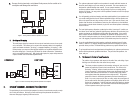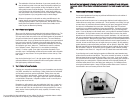
b)
The combination of the three dimensions of your room generally will pro-
duce at least three points in the room where the frequency response you
experience related to a given position (of either the speaker or you) will
either greatly increase or almost disappear. The most obvious effects are
on low frequencies, but mid-frequency effects, while usually subtler, are
also often present. Keep in mind, then, that very small changes in position-
ing (of the speakers or you) may produce major or subtle changes.
c)
Distances of speakers from the walls can make great differences in the
number, strength, and particular frequencies of secondary reflections—
changing frequency-balance, sonic spaciousness, and definition. Most lis-
teners prefer their speakers at least a few inches from all walls, but the
choice is yours to determine by listening.
2. YYou iin RRelation tto tthe SSpeakers
Where you sit in relation to your speakers obviously makes a difference too. The
proportions of the particular triangle formed by your speakers and you matter.
(You may need to send more power to the more distant speaker to compensate if
you get much further from one speaker than the other.) The overall distances
involved also matter. As you get further from the speakers, more sound reflected
from your room’s surfaces (in contrast to the sound coming directly from the
speakers) reaches your ears, and the original spatial relationships in a recording
are changed as your room “takes over.” Sometimes the result is a mellower,
more “integrated” sound. Other times, it’s a more strident or annoyingly
“echoey”—or other—quality. Once again, the particular dimensions of your
room play a part. And depending on what seems more realistic and/or enjoyable
to your ears, you may choose to sit at a great distance or have close-up, “near-
field” sound.
Keep in mind that the right “toe-in,” the right speaker height, and a reasonably
symmetrical distance from the speakers all tend to work together to deliver the
best high-frequency definition and imaging.
3. You iin RRelation tto RRoom BBoundaries
Changing your own position with respect to a room’s boundaries may also bring
a big effect, sometimes for a small change. Getting further from the wall behind
you may make sound more precise and localized. Getting closer may make
sound more “mellow” and integrated. Coming too close—to back wall, side
wall, or (especially) a corner—may trigger a major sonic peak or cancellation of
a certain band of frequencies. It depends on factors we can’t cover fully here
but do get into on our web site.
Remember too, with respect to your own positioning, that it may—or may not—
be easier to change your own seating location than to move your speakers. As
with so much else in life, the one certain rule is that you shouldn’t fix, or worry
about, what isn’t broken (audibly in this case), especially if it means moving
heavy furniture.
As you consider the three relationships we have outlined, the idea is to manipulate whatever variable
is easiest and most productive for improving your listening experience.
Be ssure tto bbase yyour jjudgements oon llistening tto aa ggood vvariety oof rrecordings oof vvocals, aand aacoustic
instruments, ssoloists, ddifferent mmovies aand mmusical iinstruments tto mmost eeasily rrecognize ttonal bbalance
shifts.
IV. POSITIONING SSURROUND SSPEAKERS
Your surround speakers and how they are positioned will determine the sonic realism of
movies and multi-channel audio.
Most surround sound is meant more to create greater depth and overall ambience than to
localize effects as coming from a particular spot. This is especially true of Dolby Pro-Logic
surround sound, in which both surround channels carry the same (monophonic) informa-
tion and can’t be differentiated from each other. With Dolby Digital and DTS surround
sound, there is very definite localization of some surround effects. How much you prefer
these localized effects vs. overall sonic depth and diffusion is up to your listening prefer-
ences. If you are listening to multi-channel music, you may want the maximum localization
of instruments. But if your main concern is the surround effects in movies, they tend to
depend more on front-to-back movement than on specific localization. You can locate and
aim your surround speakers to produce the effects you prefer, whether precisely pinpointed
or pleasantly diffused. Although some people prefer to have their surround speakers behind
them on stands at ear height, most find it easiest and best to mount compact monitors on
the walls, at least two feet above your ear height when you are seated. We offer matching
speaker brackets to make wall-mounting convenient, and our Alpha A/V, Alpha Mini, Alpha
Mite and Alpha Midi all have dimple marks on their rear panels to indicate the best place to
drill for brackets. Image 1B, 2B, and 3LR and 10S speakers include a bracket mounting
hole template in their owner’s kit. Image 3LR and 10S include flush mount wall brackets.
If your listening room is small, aiming the speakers to diffuse their sound somewhat may
produce the best overall surround illusion. They can be mounted, for instance, on the side
walls and aimed to bounce sound off the rear walls, or vice versa. If you opt for localiza-
tion of sound from the surrounds, the speakers should face your listening spot, aimed at or
slightly above your seated position. Speakers mounted on the side walls generally will
sound best when placed a foot or two behind your seating area. Our illustration shows
some typical placement options. Image 10S Bipole provides diffuse sound. Position of
front tweeters to ears can increase portion of direct sound.
Figure 3: Positioning Speakers for Music and Home Theatre






